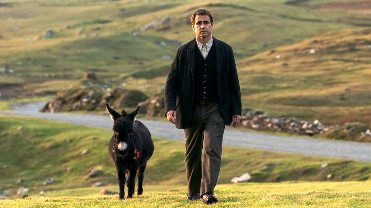 Martin McDonagh returns to Ireland for this tale of contagious madness between two friends falling out.
Martin McDonagh returns to Ireland for this tale of contagious madness between two friends falling out.
Martin McDonagh made his name as a playwright, with dramas set largely in rural west Ireland and featuring his own special brand of dark humor. The isolation and peculiar habits of his characters throw light on the conflicts and absurdities that motivate people to do crazy and destructive things. In the 2000s he started directing movies, and now his latest film returns to Ireland, powerfully reigniting the creative spark of his earlier plays. It’s called The Banshees of Inisherin.
Colin Farrell plays Pádraic, a small farmer on the fictional island of Inisherin, off the coast of County Galway in Ireland. The story, which takes places a hundred years ago, begins with him knocking on the door of his best friend Colm’s house to go to the pub together as they always do in the evening. But Colm, played by Brendan Gleeson, doesn’t answer. Pádraic can see him through the window, practicing on his fiddle, but banging on the window and speaking to him elicits no response. For some reason Colm is deliberately ignoring him.
As time goes on, and the silence continues, Pádraic demands to know why he is being treated this way. The blunt answer is rather shocking: Colm wants to spend more time composing music and developing his craft as a musician, and he thinks he’s been wasting his time talking and drinking with Pádraic instead. He says that Pádraic is a dull person whom he doesn’t like anymore.
This is a simple yet very unusual premise for a film. Pádraic doesn’t know how to deal with the rejection—it’s a small island, and losing his best friend confronts him with a loneliness he can’t accept. He refuses to take it as final, but continues to try to engage with Colm, even though Colm insists that he must stop talking to him. There’s a steadily escalating emotional pressure that begins with wry comedy and gradually becomes much more serious. We realize that although Pádraic can’t stop himself and is emotionally tone deaf, Colm himself is really rather disturbed. Almost accidentally, we also find out that in 1923 the bloody Irish civil war is going on. As a kind of echo of the personal turmoil on the island, the characters can sometimes hear gunfire on the shore, a deadly political turmoil in the distance.
Gleeson, with his burly presence and grumpy demeanor, is reliably intense as Colm, but the central focus is on Colin Farrell. I’ve seen him in lots of films over the years, and I’d say he has what you might call a movie star persona. But there’s none of that here. He plays a completely different kind of character than I’ve ever seen him do before, and it’s excellent. With a wide-eyed earnestness and vulnerable manner that reveals, against his will, a yearning insecurity, Pádraic is foolish, impulsive, yet unmistakably tender hearted. Farrell crafts this unusual man from the inside, and we see him to best effect in relationship to his sister Siobhán, played with passionate brilliance by Kerry Condon. She’s protective of her brother, but sees through the entire farce of this conflict, being really the one sane voice in the story.
McDonagh uses this small island setting, where there are only a few people to know, as a way of highlighting the volatile inner drama of how people relate to their neighbors, and their worries about what the neighbors think of them. Terrifically well written and beautifully shot, The Banshees of Inisherin pulls us in with delicious laughter, then catches us off guard with its melancholy vision of human stubbornness.

A Finnish woman on a Russian train is aggravated by the man with which she’s forced to share a compartment: an insensitive young tough...

In 1988, a British high school teacher faces the threat of being outed as a lesbian. When considering the progress of gay rights, it’s...

The sequel to the 1982 science fiction classic does not come near it in beauty, but the integrity of its vision makes it worth...